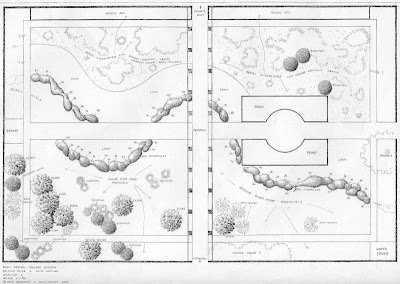Texture.It's one of the tools in the Garden Artist's wheelbarrow. I have no idea what the effect of using only fine and delicate plants in a garden would be--a fairyland? But, like anything else, any feature is best appreciated when set against its opposite. Contrasting the textures of plants in a composition amplifies each one. But manipulating texture not only creates pleasing and interesting contrasts, but you can also use it to create illusions of depth and perspective.
Detecting a plant's texture may be a bit of a challenge. The first thing to do is to train your eye. Often encyclopedias and design books do not mention the plant's texture. You have to see the whole plant (and not in the nursery where the "baby" plant may have a completely different texture than it will when full grown).
Nonetheless, the general idea is this: if you can see the details of the plant from 20 feet away, it is coarse. If it appears a solid mass from that distance, it is fine. Medium or average plants are somewhere in between--like a daylily. Another clue is the plant's leaves. Large, glossy, dark leaves reflect light (bold) and small, fuzzy, crinkly, leaves absorb or diffuse it (fine).
Of course, such distinctions are relative. A bleeding heart next to a flowering cabbage will look much more delicate than it would next to Snowcap wall cress.
As a place to start,
Northscaping provides a description of the plant's texture. Here is a collection of plants* which Northscaping classifies as fine:
 1. Dwarf Korean Meadow Rue, 2. English Cowslip, 3. Blue Heaven Bluestem, 4. Shi-un Primrose, 5. Northern Maiden Head Fern, 6. Pink Creeping Baby's Breath, (The Mosaic somehow lost these images: 7. Medora Rocky Mountain Juniper, 8. Snowcap Wall Cress, 9. Blue Arrow Eastern Red Cedar.)
1. Dwarf Korean Meadow Rue, 2. English Cowslip, 3. Blue Heaven Bluestem, 4. Shi-un Primrose, 5. Northern Maiden Head Fern, 6. Pink Creeping Baby's Breath, (The Mosaic somehow lost these images: 7. Medora Rocky Mountain Juniper, 8. Snowcap Wall Cress, 9. Blue Arrow Eastern Red Cedar.)
Here's a collection of medium coarse to coarse plants:
 1. Bressingham White Bergenia, 2. Limelight Hydrangea, 3. Bloodroot
1. Bressingham White Bergenia, 2. Limelight Hydrangea, 3. Bloodroot
4. Giant Lamb's Ears, 5. Frosty Morn Stonecrop, 6. White Bee Balm,
7. Aureomarginata Plantain Lily, 8. Pink Lights Azalea, 9. Diablo Ninebark.
Designing with Texture:
Consider the texture of the walls of your house or fence. Place a bold plant against smooth vinyl siding, or stucco for example, or an airy and lacy plant against rough stone or brick.
Without air and light to pass through it, a tightly clipped, dense, dark green hedging will make an area look smaller. On the other hand, loose light deciduous shrubs like spirea and rosa rugosa can create depth and thus make an area appear larger.
The eye is attracted to dense, bold foliage, first. You can play with this and create perspective in your small garden. For example, placing a plant with coarse texture in the foreground is supposed to create the illusion of a larger garden as the light and airy plant is perceived as farther away and so creates the illusion of greater depth.
Even though contrast in texture is desirable, it must be handled judiciously, especially in a small garden. The predominant use of one plant or texture in a garden creates a basis against which all others are seen and measured. Everything seems bolder, or more coarse or more refined than this chief texture.** Effective in a small garden is the occasional use of a bold broad leafy plant such as flowering tobacco against the more delicate blooms of lantana, gaura and verbena.***
(I couldn't resist)
1. Flowering tobacco, 2. Verbena, 3. Gaura, 4. Lantana

1. flowering tobacco (ハナタバコ) #5759, 2. Tranquility, 3. W h i t e 3, 4. Lavender Lantana
*The mosaic tool is an excellent way to see the effect of one plant against another. I may play around with contrasting textures just to see how it looks.
**A lawn can also serve as a "texture reference" for the other plants in the garden.
***recommendation from P. Allen Smith, Garden Home, p. 124
Next: The GT Week 4 tasks, BBHH.
















































.jpg)


